As the Bundesliga has drawn to a close, Hoffenheim finished in 6th place and confirmed their place in next season’s UEFA Europa League. During this 2019/20 season, they have won 15 games, drawn seven and lost 12. Hoffenheim have surprised many with their strong performances this season, having beaten many of the big sides during their campaign, such as an away win at Bayern Munich and a home win against Borussia Dortmund.
Since the resumption of the league from the global pandemic, Hoffenheim won five out of their last nine games, having drawn two and losing two. They recently parted company with Alfred Schreuder with only four games left due to a difference in ideas on the club’s future. He was in charge for 33 games, which saw Hoffenheim score 42 goals in all competitions this season under his reign.
This tactical analysis of Hoffenheim will analyse their 2019/20 season which sees their place confirmed for European football next season. The analysis will look at their defensive line when out of possession, as well as depict their penetration in possession and conclude by examining their decision making in the final third, along with their tactics under Alfred Schreuder till he left the club.
Hoffenheim’s defensive line out of possession
This season, Hoffenheim have conceded 53 goals, which is slightly higher than their xGA of 51.7. Their xGA per 90 currently sits at 1.61 and they leaked in 13 goals in their first 10 matches of the season. Although Hoffenheim finished in sixth place and had a great season, their defensive line when out of possession is something that needs to improve if they are to make a name for themselves in Europe next season.
During many games under Schreuder, Hoffenheim’s backline has been very unorganised, meaning teams have been able to exploit the spaces to create goal-scoring opportunities. The main downfall of Hoffenheim’s lack of organisation is due to individual players being out of position, allowing the opposition to utilise and dominate these spaces.
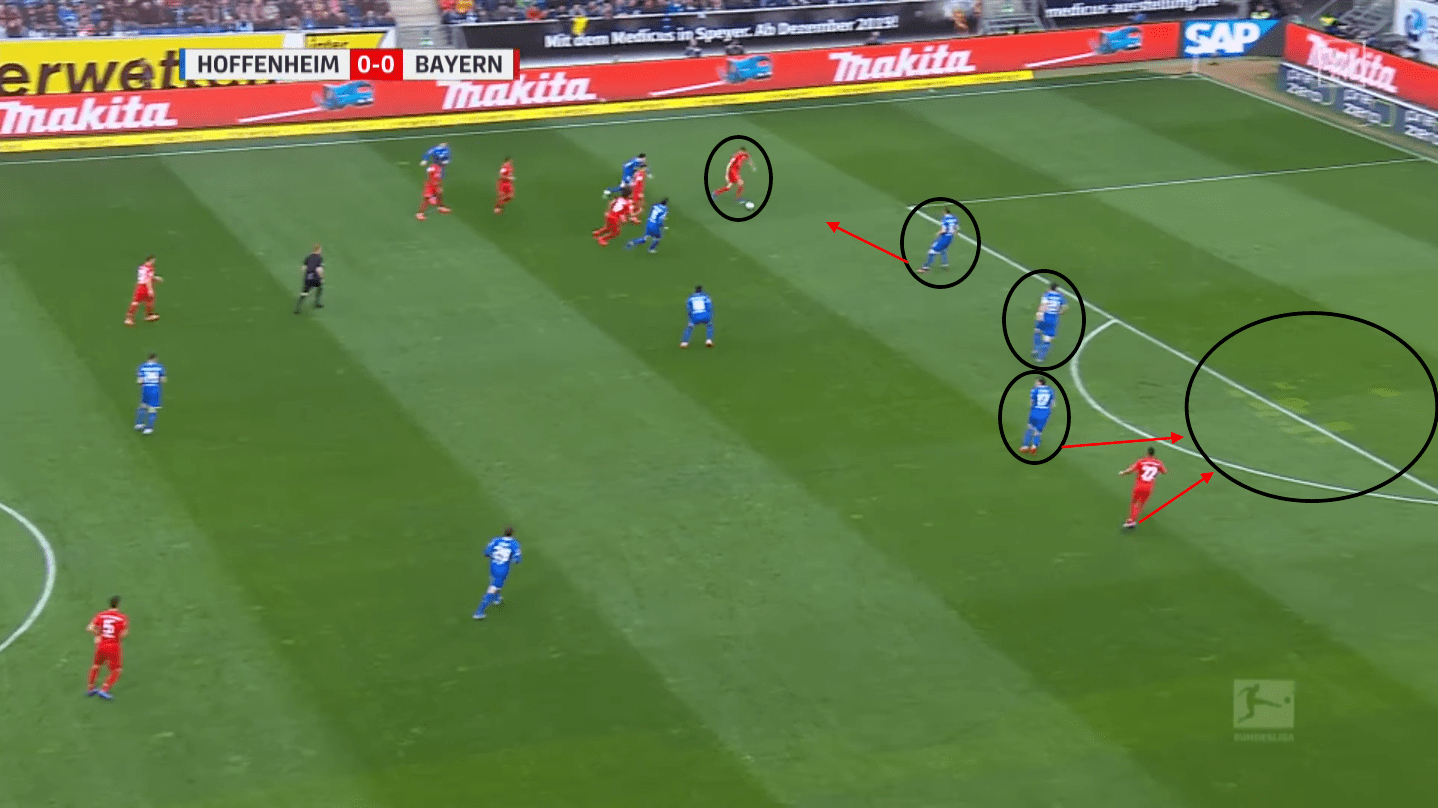
Hoffenheim’s biggest loss of the season was a home game against Bayern Munich at the end of February 2020 where they lost 6-0. Schreuder fielded a 4-2-3-1 formation which he has used 23.7% of the time this campaign. Hoffenheim’s back four was one of the main reasons why Bayern were able to win by a huge margin.
In the image above, Bayern have the ball in the left advanced half-space, having regained possession from Hoffenheim when they were trying to progress the ball out of their defensive third. As Bayern regain the ball, Hoffenheim’s players who make up their defensive line are all out of position, enabling Bayern to play the ball across to the back post to take a 1-0 lead early on in the game. Firstly, Håvard Nordtveit, Hoffenheim’s right central defender, needed to go and apply direct pressure to Thomas Müller to make it difficult for him to enter the penalty area and produce a cross. Secondly, Benjamin Hübner, the right-sided central defender, needed to apply cover to Nordtveit, so if Müller was able to beat Nordtveit or produce a cross, Hübner was the cover player to apply pressure again and prevent them from executing a shot at goal. Lastly, Steven Zuber, Hoffenheim’s left-back, should have been goal-side of Gnabry and providing the balance to the backline.
Throughout this game against Bayern, Hoffenheim’s defensive line failed to carry out the basic principles of ‘pressure, cover and balance’ when their back four found themselves out of possession and attempted to prevent Bayern from breaking down this line.
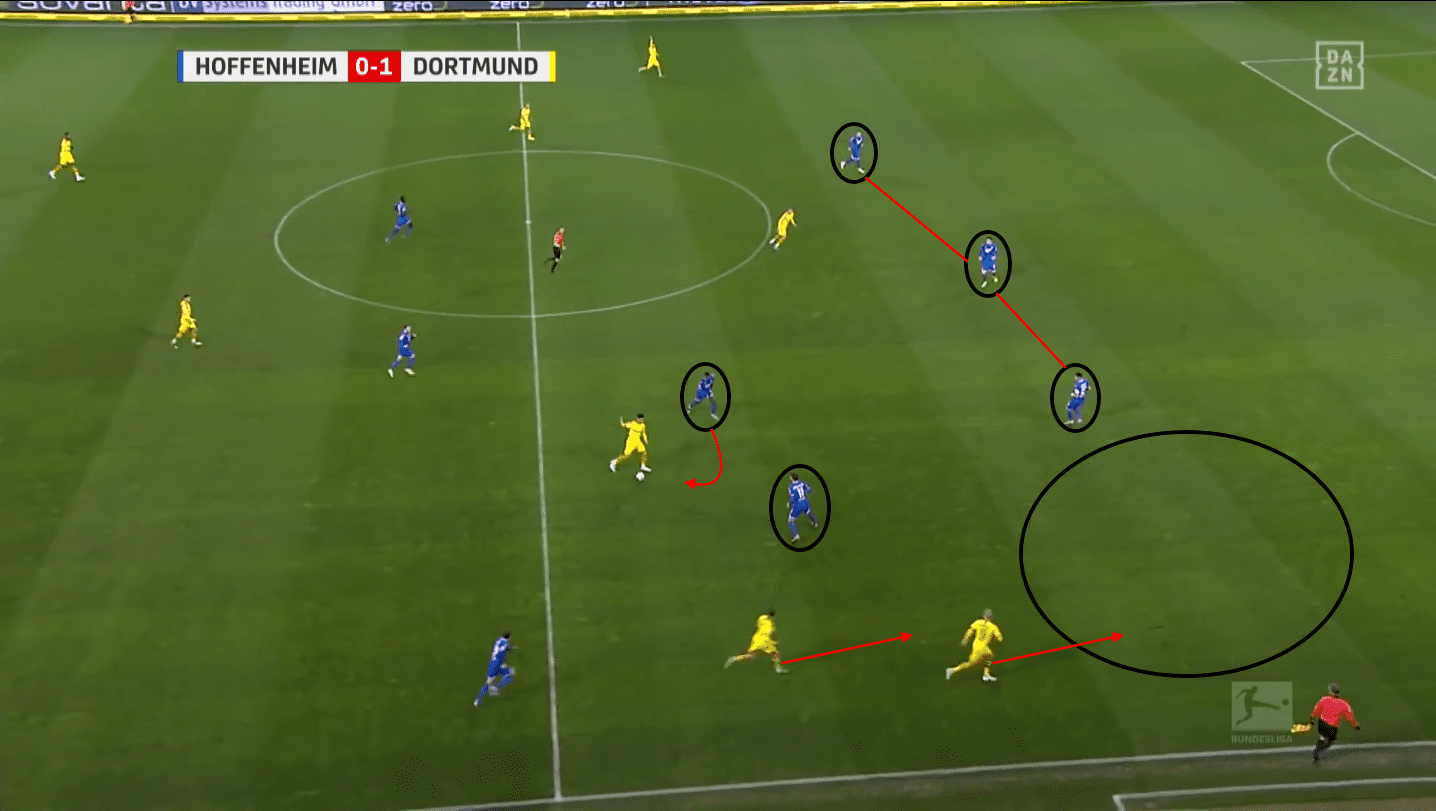
Matchweek 17 saw another home for Hoffenheim but this time against Borussia Dortmund, and they again found themselves a goal behind in the early stages of the game. Schreuder opted for a back four once more, and they failed to prevent Achraf Hakimi and Thorgan Hazard from dominating the right side with the ball. They failed to stop the Dortmund progression of the ball due to the problem of their back four which can be seen in the image above and happened on many occasions in this game. As Dortmund’s Julian Weigl has the ball just after the halfway line, Robert Skov, Hoffenheim’s left-back, decides to go and apply pressure to Weigl, which then creates space for Hakimi and Hazard to run into, to receive.
Instead, if Skov had stayed in his position, this would have prevented Hakimi and Hazard both making forward runs to break down the back line. Skov should have let Florian Grillitsch perform the press, who was Hoffenheim’s single pivot player. This would have forced Dortmund to find a different avenue to try to progress, as well as allowing the Hoffenheim back four to keep their defensive shape.
Hoffenheim are currently the third highest team in the league to have the most shots against them. They average 13.03 shots against per 90, which is slightly above the league average of 11.65. In the league this season they have kept eight clean sheets and are the 8th lowest team in the league for goals conceded.
During the home game against Paderborn, Hoffenheim found themselves with a comfortable lead going into half-time and their defensive line was very organised which prevented Paderborn from finding any way back.
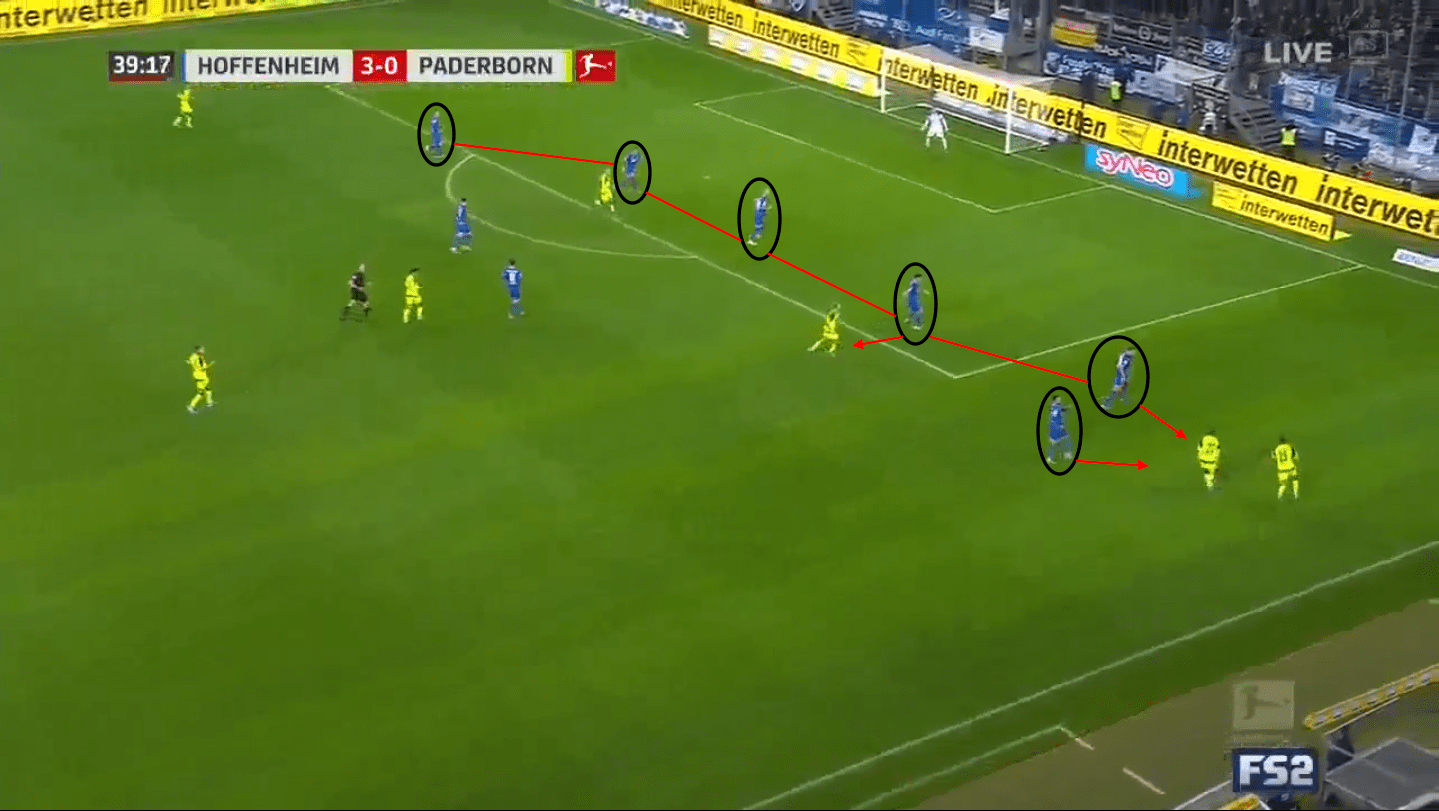
For this game, Schreuder went with a back five instead of his favoured three/four and their organisation as a unit was clear for all to see. In the above example, each player consisting of the back five are a good distance apart from one another whilst out of possession, making it hard for Paderborn to exploit the spaces and penetrate the last line of defence. Hoffenheim have players applying pressure to prevent the cross, and the rest of the defensive unit applying the cover and balance, making their shape very structured and hard to break down.
Each player is in their respective positions and covering one another which makes them very hard to attack and penetrate. If Hoffenheim had done this against the bigger teams such as Bayern and Dortmund then they may have been able to keep more clean sheets this season.
It could be argued that when Hoffenheim play in a back four they are less organised and structured out of possession than in a back five.
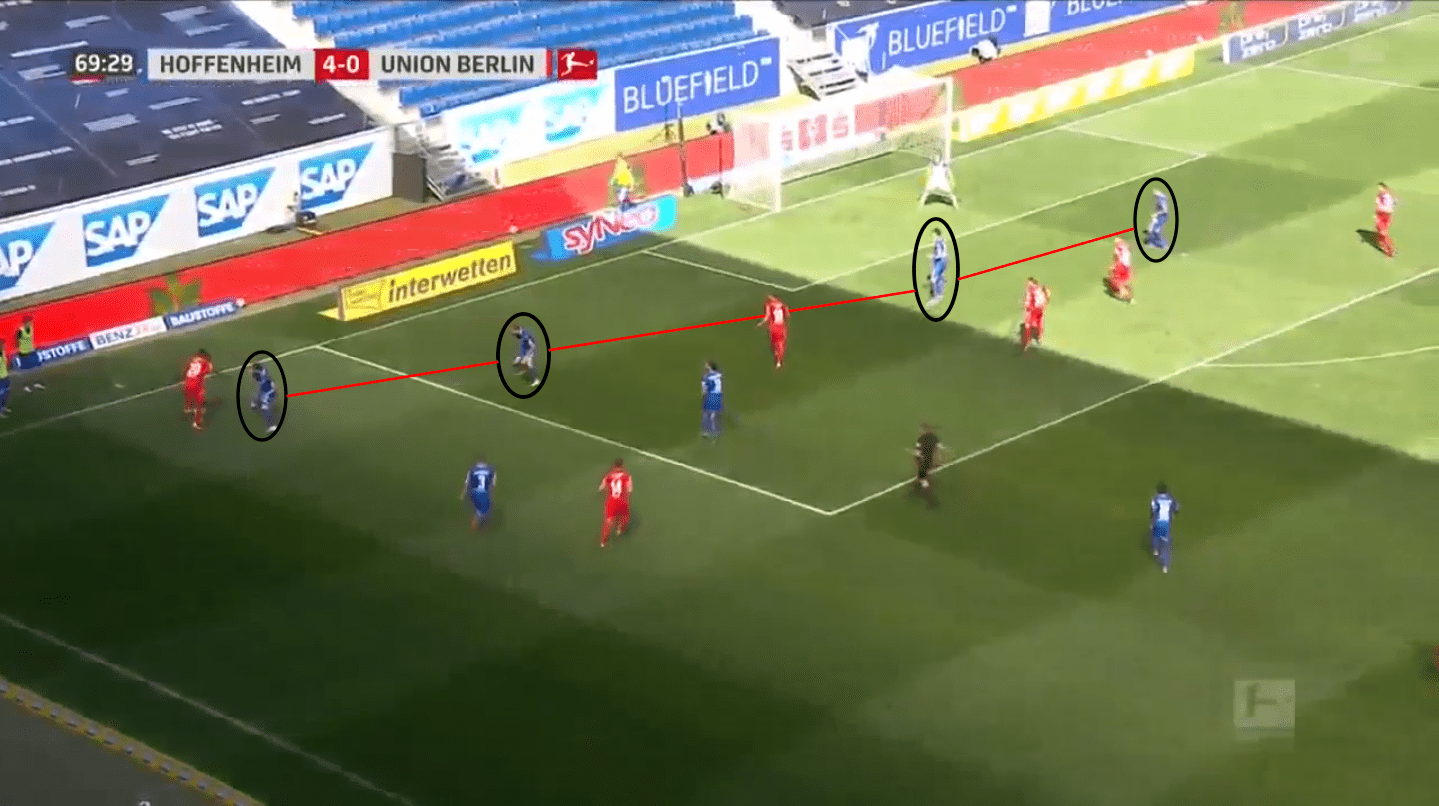
Against Union Berlin in their last home game of the season under interim boss Matthias Kaltenbach, they set up in a back three with Grillitsch sitting in front as the single pivot. In the above scenario, Berlin are looking to cross the ball into the box from a deep position. Looking at Hoffenheim’s backline, they seem very organised and all goal side. However, Andersson, Berlin’s prolific striker, has found space in-between the two Hoffenheim central defenders and if the ball is played in then they could have a good opportunity to guide the ball towards goal without any pressure. If the defensive unit shifted more towards marking man to man then this would have condensed the space for Berlin to exploit in the box.
Their defensive line organisation is something that their new manager, whoever that may be, will need to address when either in a back three, four or five if they want to have a good run of form in Europe and the Bundesliga next season.
Penetration when in possession
In addition to their performance as a unit out of possession, this analysis will also analyse Hoffenheim’s penetration when in possession of the ball and how they use the ball to penetrate the opposition. Hoffenheim have scored 53 goals this season which sees them exceeding their xG tally of 48.7. Their penultimate game against Union Berlin saw them surpass their xG per 90 of 1.48 by winning 4-0, and their last game away at Dortmund saw them achieve another 4-0 win.
Throughout this season, Hoffenheim liked to penetrate the opposition defensive lines whilst trying to progress the ball in all three thirds of the field. This section of the analysis will look into how Hoffenheim penetrate in each section and what has contributed to them being able to progress the ball effectively during many different matches.
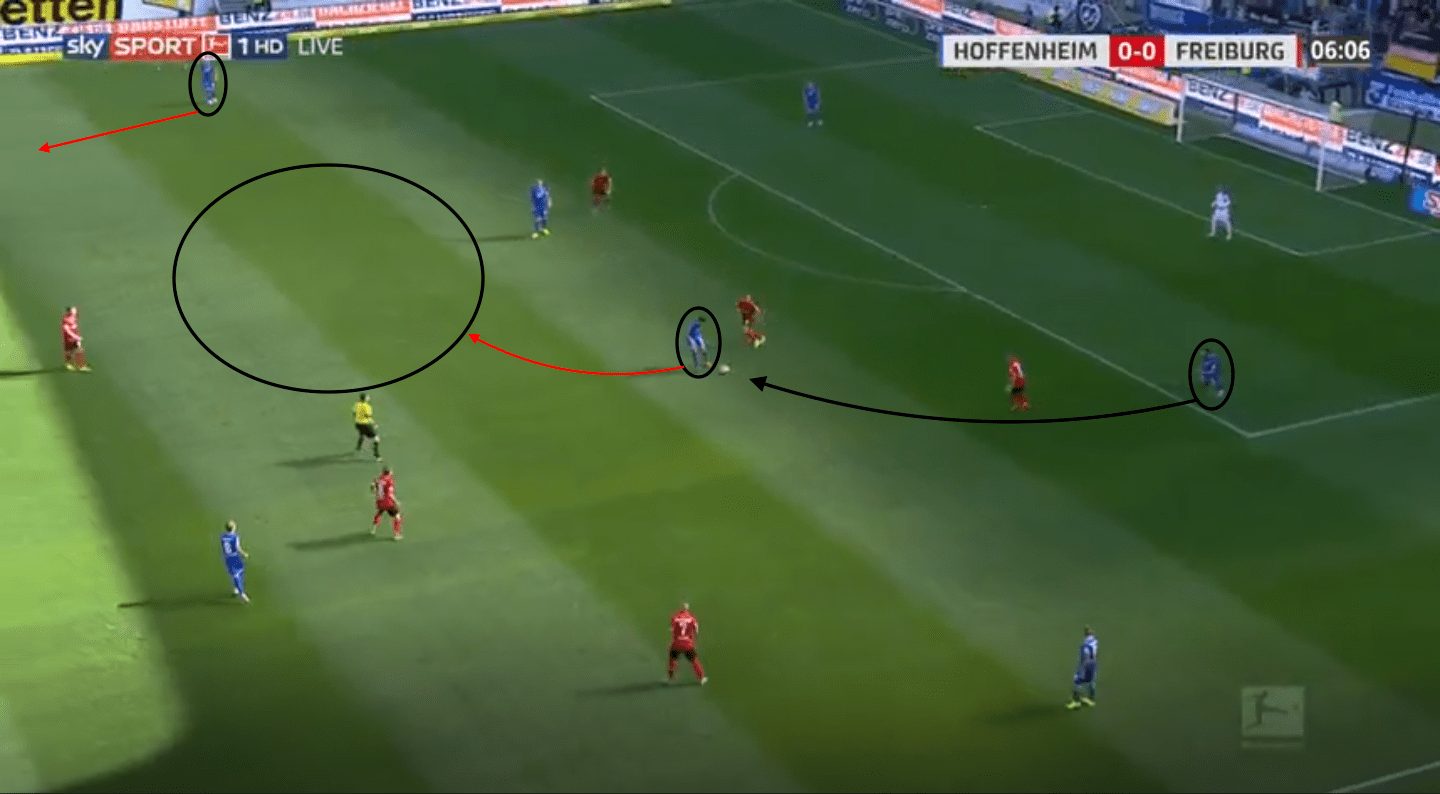
In their game against Freiburg, we saw early on in the game how they use their two central midfielders to advance through the thirds. As Hoffenheim play out from the back and give the ball to their left central defender Ermin Bičakčić, a penetrative pass that breaks the Freiburg press is made from Bičakčić to Grillitsch who drops in to receive. This pass has taken out three of the Freiburg attacking players and Grillitsch is able to create an overload in the central area in the midfield third.
If Hoffenheim’s penetration with the ball from their own third is through the wide areas, they still look to use their pivot or central midfielders, and Grillitsch in particular, to penetrate the opposition lines further up the pitch.
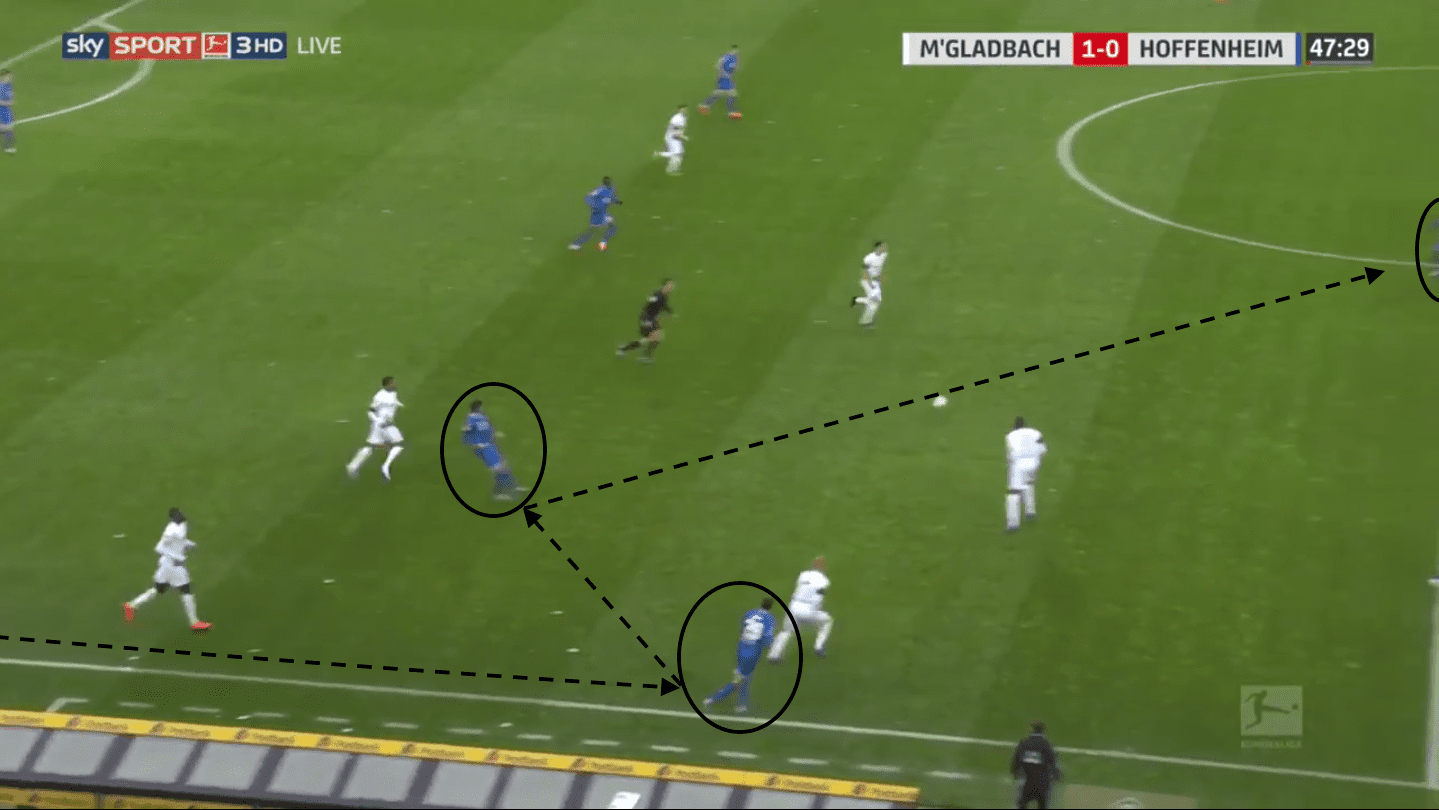
In this example, shortly after half-time away to Borussia Mönchengladbach, Sebastian Rudy, Hoffenheim’s right-back, played the ball into the receiving Skov. This pass penetrated the Gladbach initial press. After receiving, Skov played the ball back to Grillitsch, who was then able to play another split pass to penetrate the Gladbach second line of defence to Moanes Dabour, who dropped in to receive in between the lines. This passage of play is commonly known as ‘up, back, through’ and in the space of three passes, Hoffenheim were in the opposition’s half and had broken down two lines of press.
Grillitsch has had 2072 touches of the ball this season, the most of any other Hoffenheim player. He averages 58.26 passes per 90 and 70.33% of his passes into the final third this season have been accurate. It was clear to see that, with the evidence of the stats also, Schreuder used Grillitsch as a main player to penetrate the opposition when in possession.
In the same game, Hoffenheim used the central area to penetrate which took them from the midfield third into the final third.
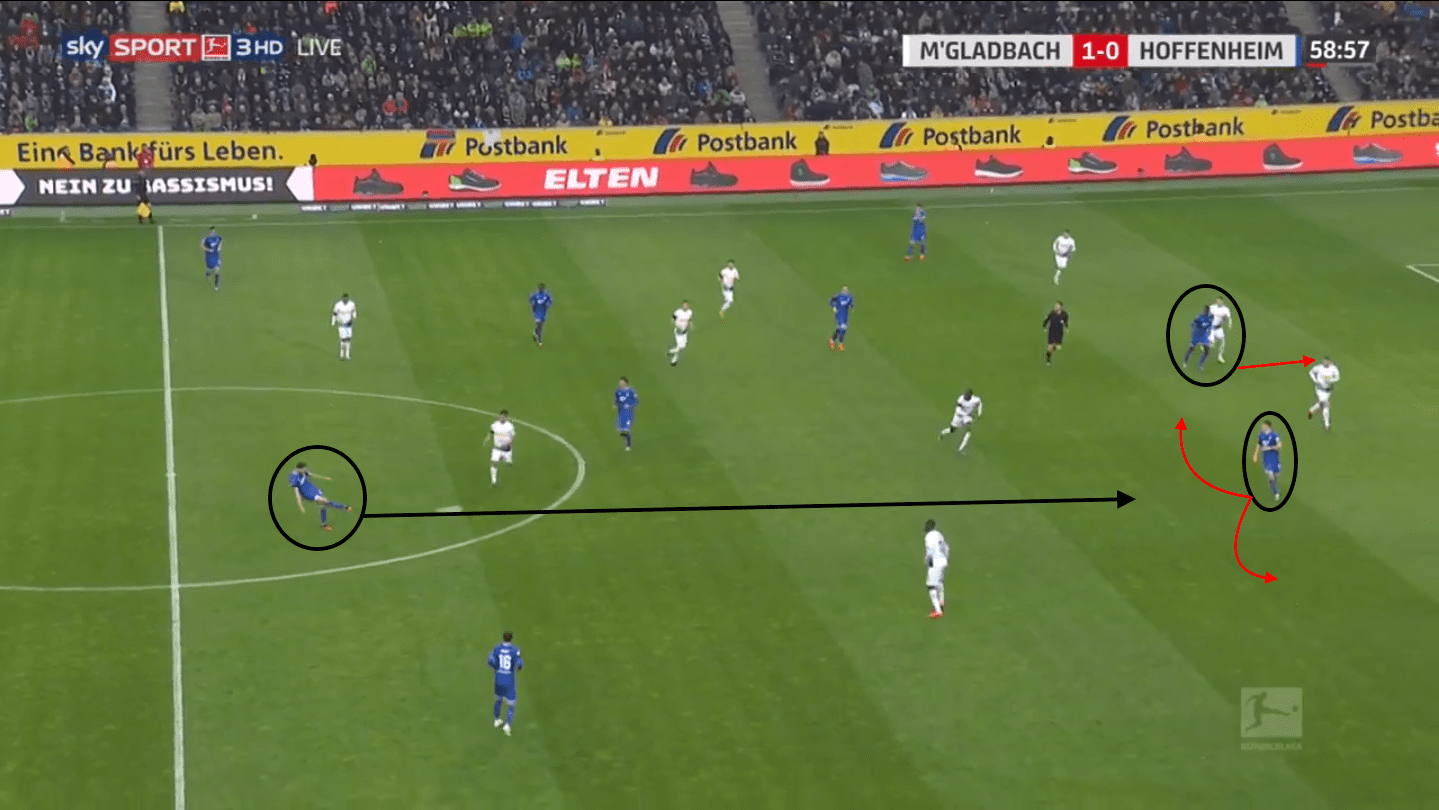
As Nordtveit has possession in the midfield third, he plays a penetrative split pass forwards through the Gladbach midfield line to Dabour who has made a movement in between the lines to receive. Hoffenheim also have Diadie Samassékou who is making a run in between the Gladbach central defenders to provide another chance for Dabour to penetrate the defensive line when he receives the ball.
Hoffenheim’s central defender Hübner can be seen as a player who is key for them to be successful and effective when in possession. Out of the 25 league matches he has played in this season, he has produced 705 forward passes and 582 have been accurate. Stefan Posch, who commonly plays alongside Hübner, has played 28 games in this campaign and produced 539 forward passes, of which 398 have been accurate. Posch has made 160 passes into the final third and 95 have been accurate. It could be argued that these players are key in penetrating the opposition when they have possession of the ball and are able to produce an accurate pass in decisive moments.
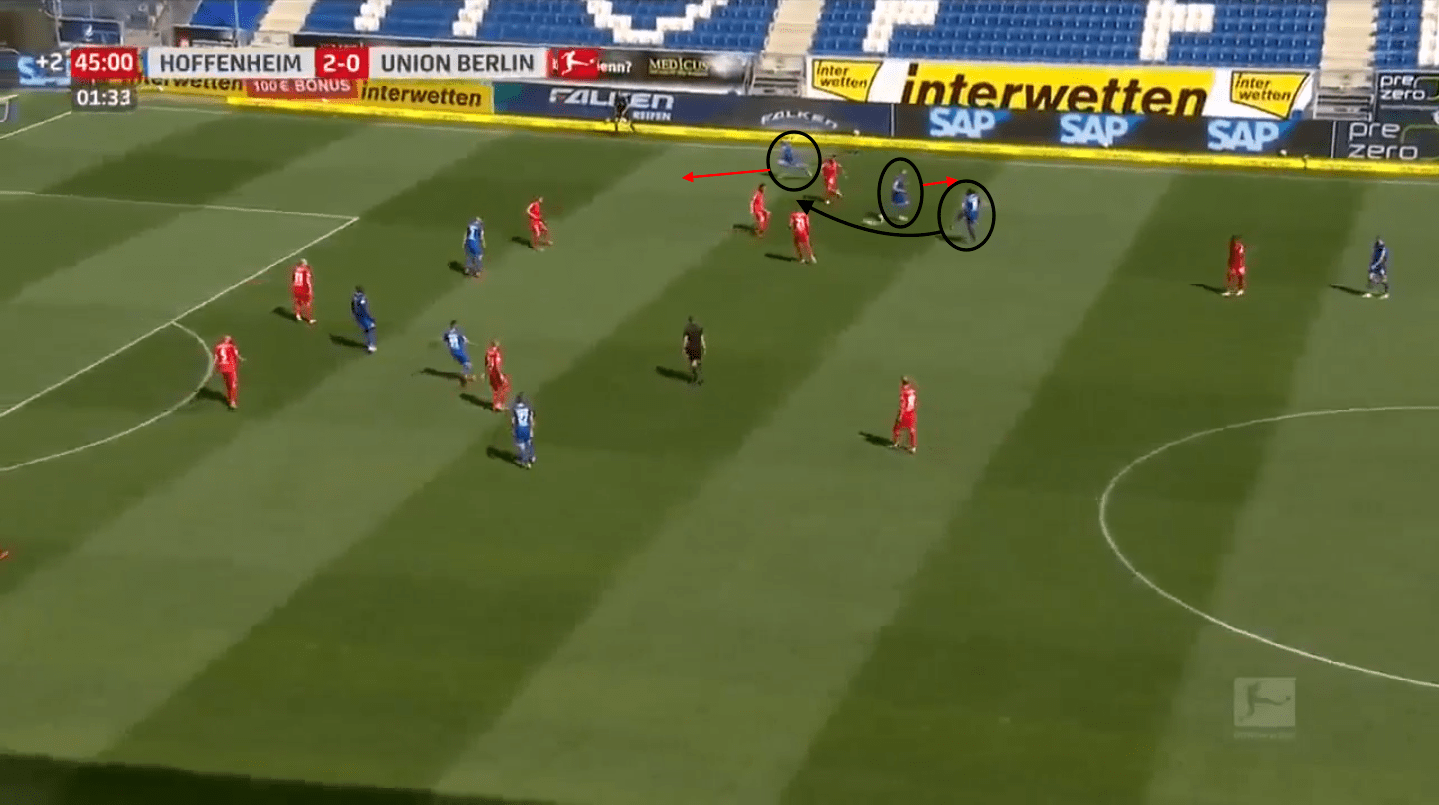
When Hoffenheim have the ball in the wide areas and still look for ways they can penetrate the opposition, their clever player rotations in the half-spaces produces space for them to exploit the opposition in key areas.
In this scenario, Grillitsch has the ball and needs options to penetrate in forward areas. Pavel Kadeřábek, Hoffenheim’s right back, vacates the right half-space by making a backwards horizontal run. This then creates space for Dabour to run into from the wide position and gives Grillitsch an opportunity to play a penetrative pass forwards behind the Union left full-back position.
In their recent 4-0 win in the last game of the season away at Dortmund, Hoffenheim used the wide areas once more to penetrate when in their build up stage, as we can see from the image below.
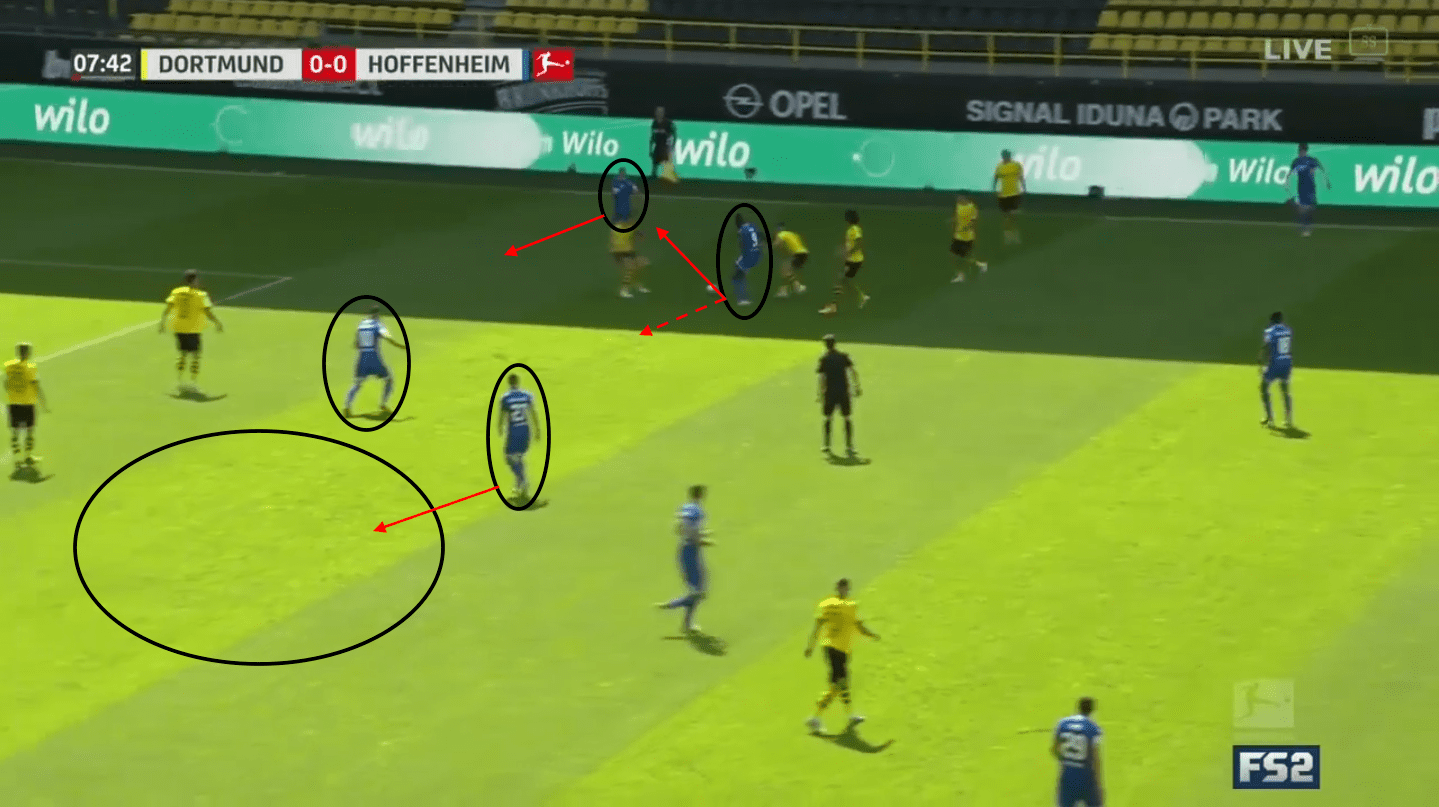
As half-time approached and as Hoffenheim searched for their third goal, Skov was in possession high in the left-back position and played a forwards pass into Moanes Dabour, who had made a checked run to the left wing to receive. As this pass was made, Hoffenheim were able to stretch the Dortmund back three, which allowed Dabour to play a lateral pass into the path of the waiting Andrej Kramarić who was able to carry the ball forwards and penetrate the space in between the Dortmund defensive line.
Hoffenheim’s use of their central players to penetrate as well as rotations in the half-spaces allows them to successfully advance forwards and exploit the spaces in key areas behind the opposition.
Decision making in the final third
Whilst penetrating the opposition in key areas is vital for any team to be able to create goal-scoring opportunities and threaten the opposition, the decisions that are made in the final third are decisive in whether a team can be successful in these vital areas. Hoffenheim average 16.88 touches per 90 in the oppositions penalty area which is roughly around the league average of 16.91.
The decisions the ball carriers make when in the final third have had a massive impact on the success of Hoffenheim when in possession.
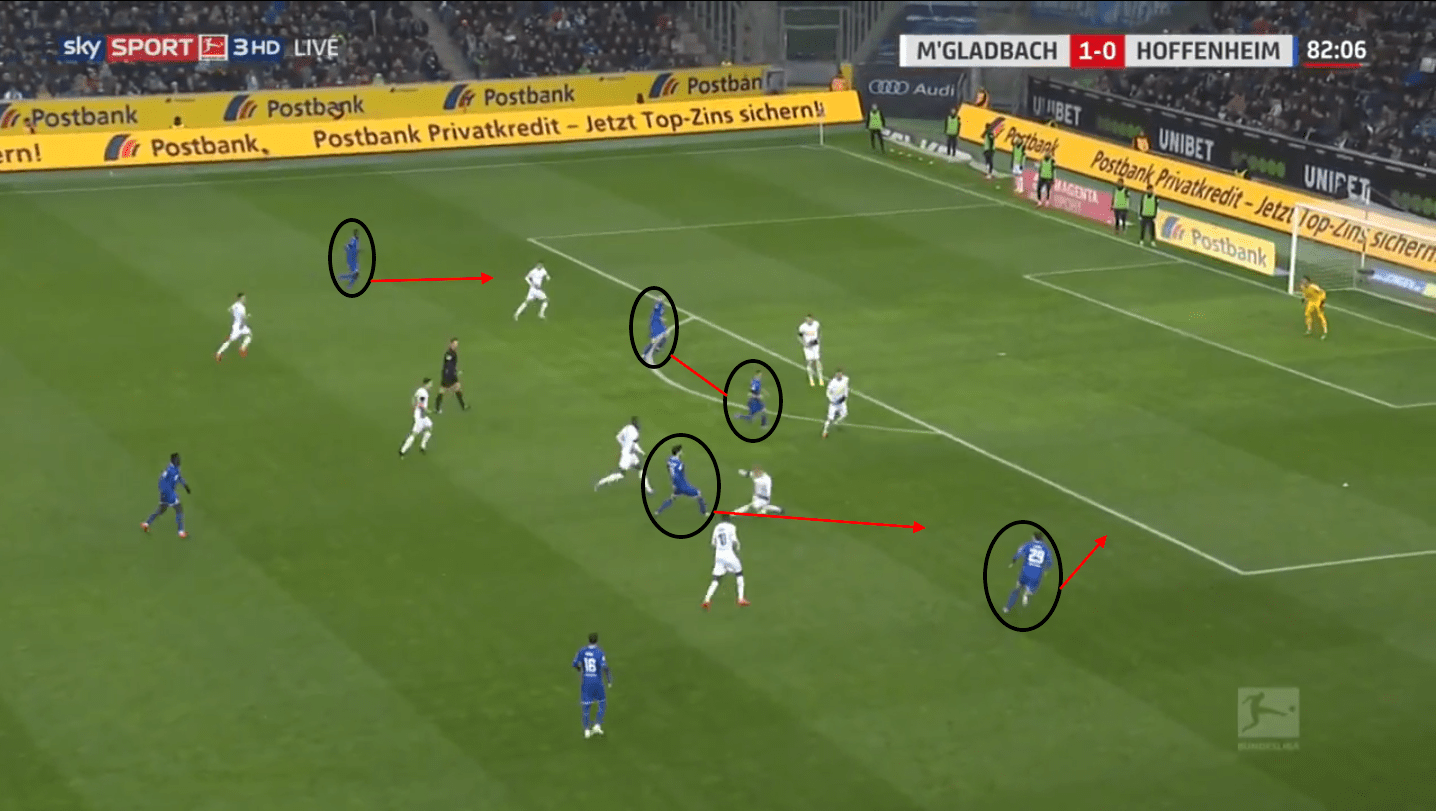
In the Gladbach game, and searching for an equaliser, Grillitsch again entered the final third with the ball and looked to penetrate the Gladbach defensive line. We can see in the photo above that Hoffenheim has two players exploiting both the half-spaces on both the left and right sides. The forward run from Grillitsch encourages a defender to come out of position and a decision to play a forward pass around this press into Skov who is in the right half-space sees Hoffenheim draw ever closer to an equaliser.
If the build-up play has come from the wide areas then Hoffenheim’s decisions to make a cross in the final third and timing of the run from players off the ball to receive in dangerous areas gives Hoffenheim hope as we see below against Dortmund.
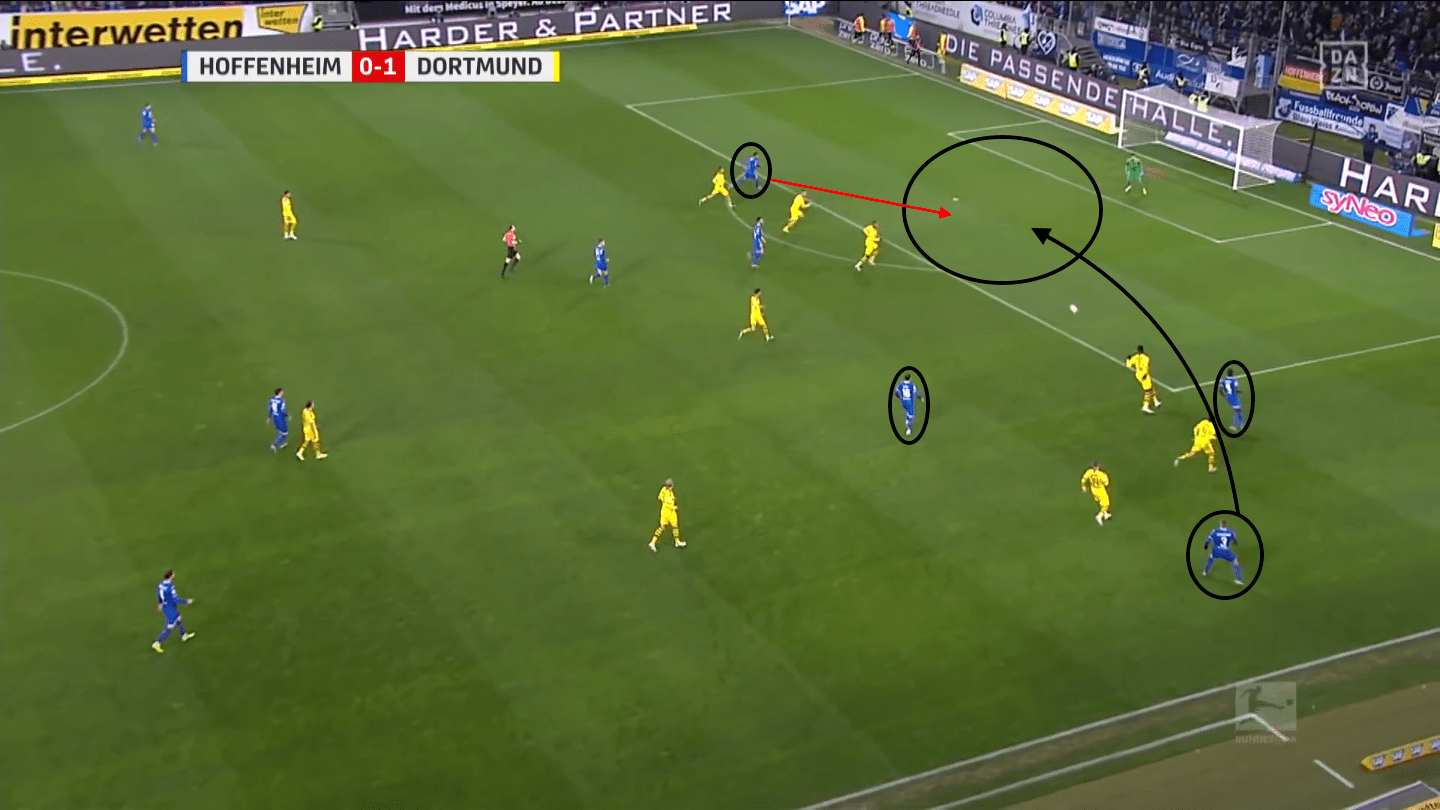
In this scenario, we see another good decision from Rudy in the final third which gives Hoffenheim a shooting opportunity. Rudy has the ball in the wide right area and is being pressed by two Dortmund players. He could have made the decision to advance further forward and try and cross from a tighter angle. However, he notices Christoph Baumgartner making a run towards the back post and delightfully places a cross in between the Dortmund defence and goalkeeper for Baumgartner to get onto.
Although Hoffenheim didn’t score from this chance, the decisions that the players make with the ball in the final third give them numerous chances to get back into the game.
In the away game against Union Berlin, their key decision making in the final third was apparent once more, when Ihlas Bebou squared the ball to Andrej Kramarić in a 2 vs 1 situation to create a goal-scoring chance.
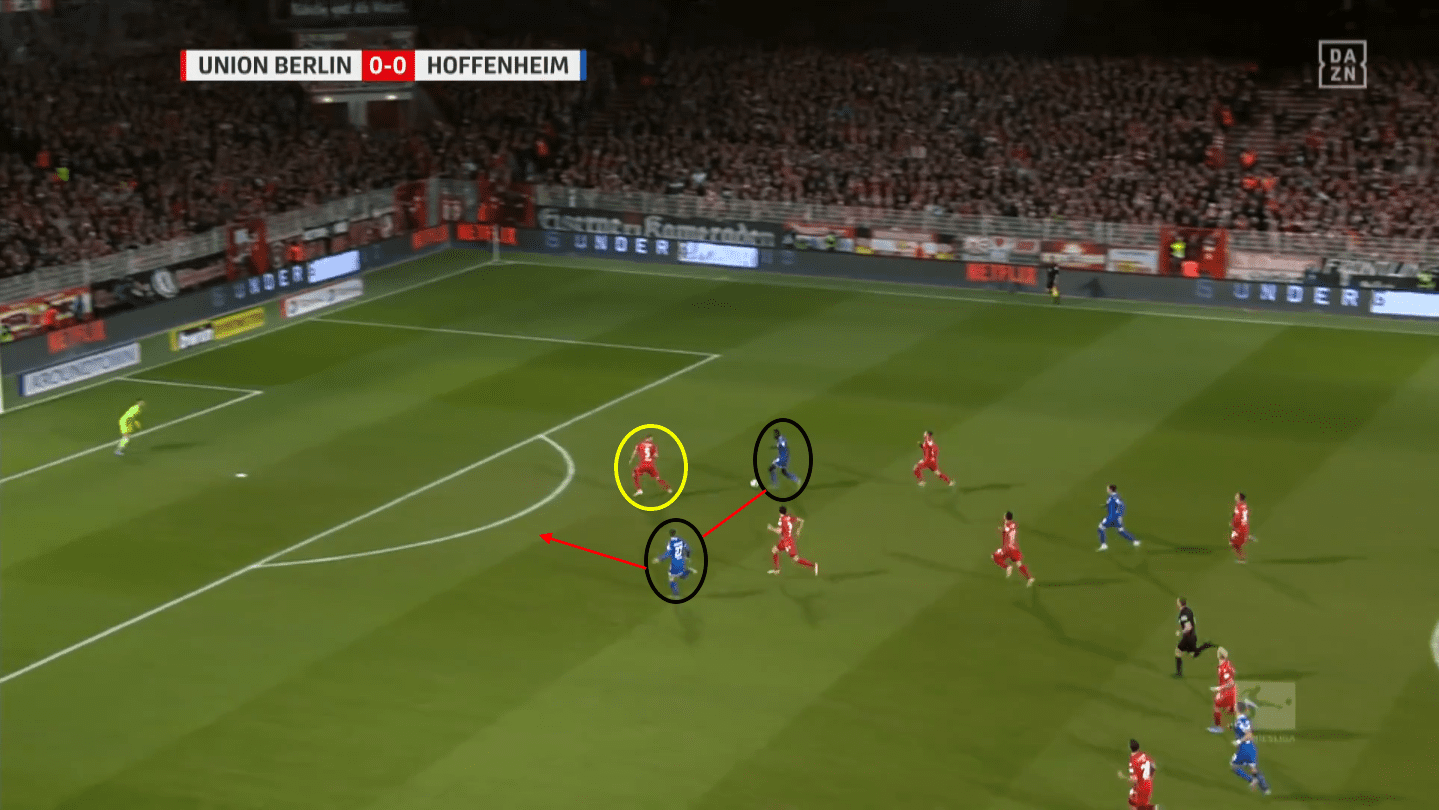
Bebou and Kramarić create a 2 vs 1 situation in the final third and instead of Bebou trying to beat the defender 1 vs 1, he plays a forward pass into the path of Kramarić who is then 1 vs 1 against the goalkeeper. A poorly executed shot by Kramarić meant Hoffenheim were not able to get back into the game from this chance, however the decision from Bebou to play the pass and the timing of the run off the ball from Kramarić game Hoffenheim the confidence to get back into the game and take all three points.
In the first half of their impressive away win at Dortmund, Hoffenheim overloaded the right half-space which meant they were able to penetrate the defence and enter the final third. The timing of the runs off the ball from support players as well as the timing of the pass from the ball carrier made their decisions to overload a huge success.
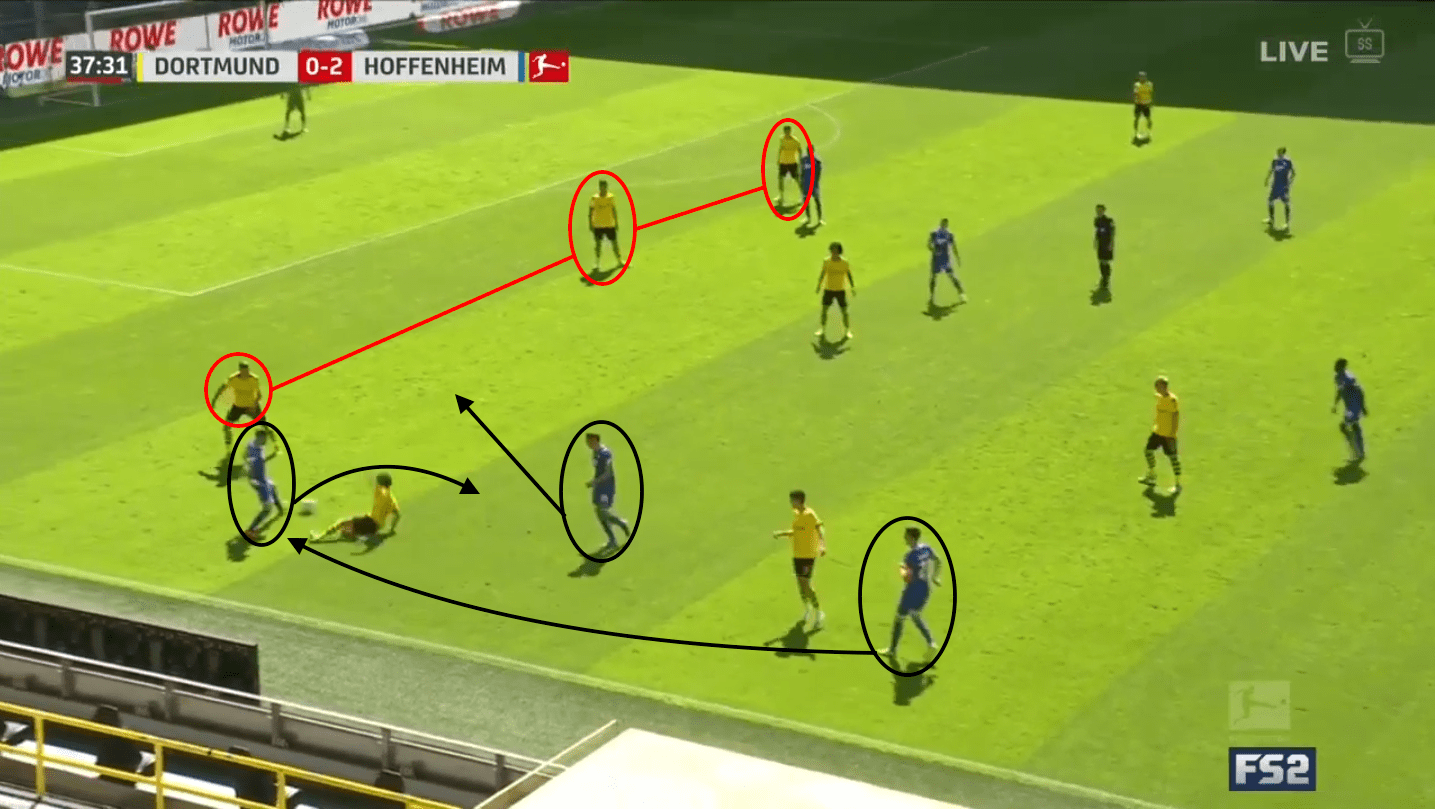
In this situation, Ihlas Bebou has the ball in the right half-space and has created a 2 vs 1 overload with Pavel Kadeřábek as they look to enter the final third. Bebou’s decision to pass to Kadeřábek forced Hummels to go and press, leaving the central space free for Andrej Kramarić to receive and strike home to make the score 1-0.
Their overload of the half-space to enter the final third and their decisions on and off the ball allowed them to gain success in these dangerous areas.
Conclusion
This tactical analysis has examined Hoffenheim during the 2019/20 Bundesliga season. The analysis opened by analysing their defensive line out of possession and provided solutions to their issues to prevent teams from exploiting them easily. The analysis then continued to look at their penetration in possession and how they commonly use their central players to penetrate the central spaces. The analysis concluded by dissecting their final third play and how this has contributed to them finishing the Bundesliga 2019/20 campaign in sixth place.
Hoffenheim have been very effective going forwards this season under Schreuder and it will be interesting to see how they play next season under a new manager. If the new manager addresses their defensive unit problems and opts to be more consistent in their defensive formations, as well as continuing to use their effective players going forwards, will see them as a real threat not just in Germany but in Europe also.

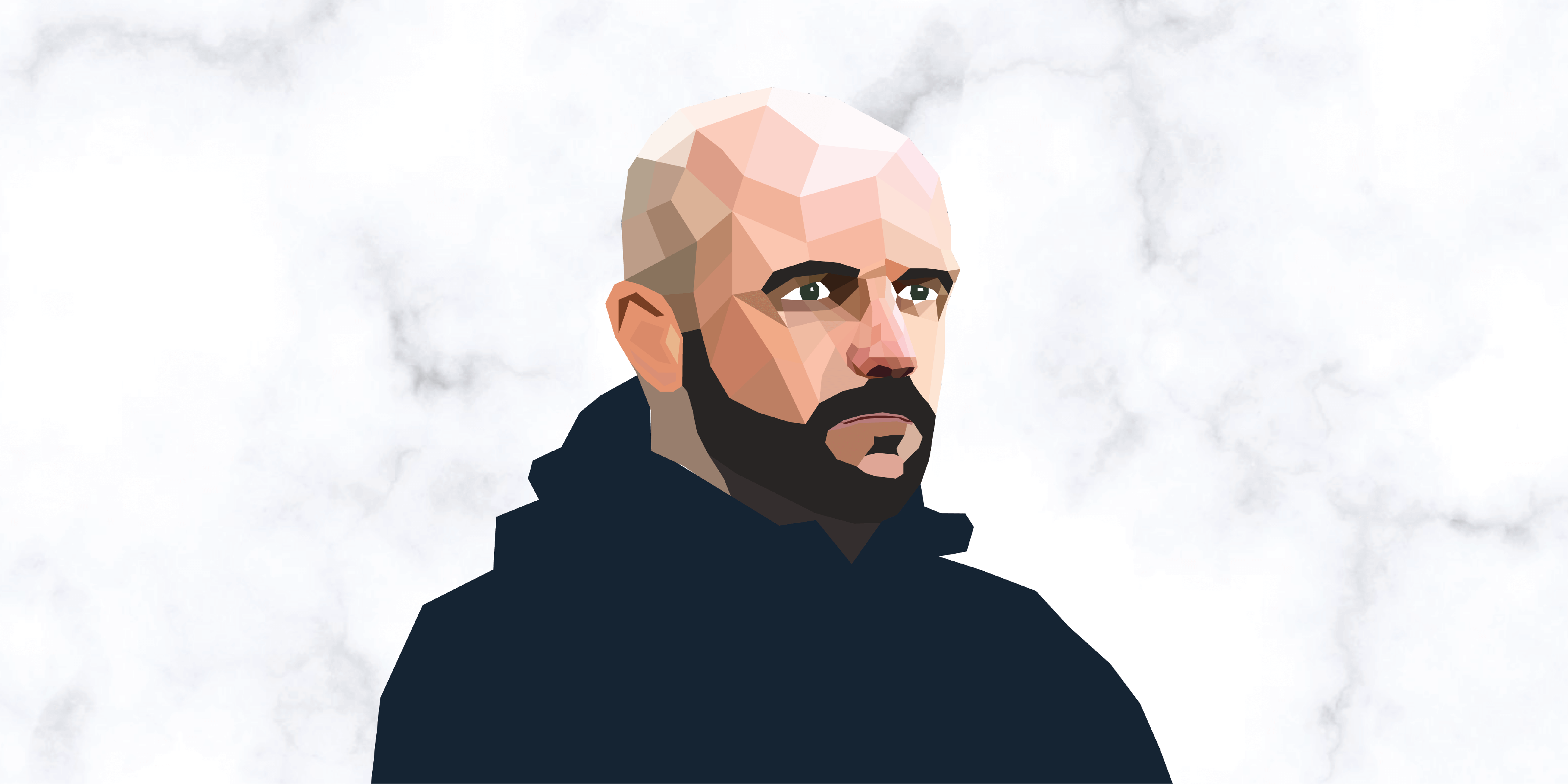



Comments